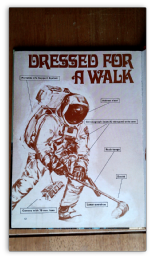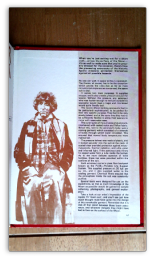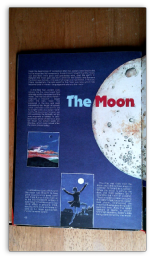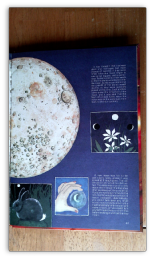Who's Moon (an Annual view)
 I was recently fortunate enough to receive my copy of the newly published “Doctor Who and Science: Essays on Ideas, Identities and Ideologies in the Series” (edited by Lindy Orthia and Marcus K Harmes, Macfarland, see Amazon UK). This fantastic volume explores thirteen different approaches to thinking about science, its literary themes and science communication in the classic BBC television series. These range from in depth analyses of Victorian science and representations of dinosaurs, to explorations of gender identity and two essays on astrophysical topics: JJ Eldridge’s exploration of alien worlds in the Whoniverse, and my own contribution on the roles played by Earth’s Moon. Primarily an academic text, the book is nonetheless designed to be accessible to interested readers from non-academic or interdisciplinary backgrounds, and is thus itself an example of science communication arising from science fiction.
I was recently fortunate enough to receive my copy of the newly published “Doctor Who and Science: Essays on Ideas, Identities and Ideologies in the Series” (edited by Lindy Orthia and Marcus K Harmes, Macfarland, see Amazon UK). This fantastic volume explores thirteen different approaches to thinking about science, its literary themes and science communication in the classic BBC television series. These range from in depth analyses of Victorian science and representations of dinosaurs, to explorations of gender identity and two essays on astrophysical topics: JJ Eldridge’s exploration of alien worlds in the Whoniverse, and my own contribution on the roles played by Earth’s Moon. Primarily an academic text, the book is nonetheless designed to be accessible to interested readers from non-academic or interdisciplinary backgrounds, and is thus itself an example of science communication arising from science fiction.
Having now read the work of my excellent co-contributors, I was particularly struck by the essays by Tonguç İbrahim Sezen and Mark Erickson, both of which explored Doctor Who’s paratexts (material produced in association with the series to support fan engagement and world-building, such as “Science of…” books or articles in annuals). As well as providing serious food for thought on their own topics, this reminded me of an aspect of my own topic which I had neither time or space to explore in my chapter: the frequent use of Apollo-era information and imagery in Doctor Who annuals.
Annuals
Annuals, for those unfamiliar with the term, are hardbound volumes typically A4, Letter paper or Foolscap in size, produced as tie-in merchandise for existing franchises and usually aimed at juvenile audiences and the Christmas gift market. As such they are often dated to look forward to the year ahead, rather than the almost-exhausted year in which they are published. They have historically been most common in the United Kingdom, and can relate to source materials as varied as comic books, television programmes and favourite sports teams or bands. They have also evolved over time from relatively thick, content-rich books with abundant original stories and articles (common in the 1950s and 1960s) to slighter volumes with a pronounced focus on visual imagery, games or puzzles and relatively little original material (more common in current examples). Nonetheless, even contemporary annuals retain articles on factual material - whether this is written pedagogically or with an in-universe style and content. As such, they provide an interesting insight into those aspects of the “real” world which are deemed relevant or of interest to their young audiences (at least by adult writers at the time).
Doctor Who annuals were published in the UK annually from 1965 to 1985 (except 1971) and again from 2005 to 2020. Additional annuals and yearbooks were associated with other spin-off and franchise media. While I do not have ready access to all of those annuals, I want to highlight two examples of representations of the Moon drawn from annuals featuring Tom Baker’s Fourth Doctor, and highlighting the very varied ways in which scientific content could be presented to children at the time.
Image: Doctor Who Annual 1980, front cover
“Dressed for a Walk”
“Dressed for a Walk” is a double-page article in The Dr Who Annual 1979 (published by World Distributers (Manchester) Ltd in the autumn of 1978, pg 62-63). In fact, the article is mounted within the back cover of the annual, and is thus the lingering memory left in the minds of its enthusiastic young readers. The article presents a labelled, full-page artistic image of the Apollo-era lunar surface space suit, together with a column of text describing it and providing context.
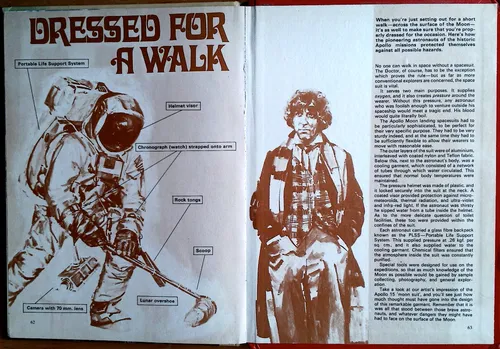
The article is highly technical in tone and content. Materials, components and capabilities of the suit are described, with quantitative values given for the pressure maintained by the life support system. While the Doctor is mentioned briefly as not needing such a suit, the article could reasonably have appeared in a child’s technical magazine rather than one focussed on Doctor Who. Emphasis is placed not only on the materials technology but also on the scientific exploration remit of the Apollo missions, with the image including sample collection and camera equipment and the text emphasising its design “so that as much knowledge of the Moon as possible would be gained”.
This article then is overtly placed as an effort to educate and inform readers, albeit in the context of a volume intended also to amuse and entertain. It is overtly scientistic in tone and also placed within the narrative of science triumphalism (see Erickson in “Doctor Who and Science”) in describing “how much thought must have gone into the design of the remarkable garment” as well as extolling “the brave astronauts” who wore it.
“The Moon”
“The Moon” a double-page article in the following year’s Doctor Who Annual 1980 (World Distributors 1979, pg 46-47), takes a strikingly different approach. Like the previous year’s article, its connection with the Doctor is slight. Unusually for factual content in a science fiction paratext of the time, however, it appears to privilege traditional rather than scientific knowledge.
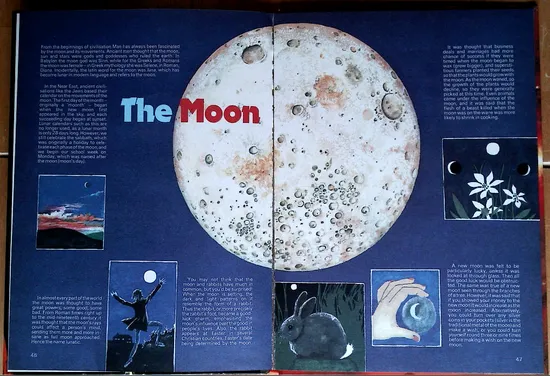
The article gives examples of the use of the Moon as a calendrical marker, but also explains concepts of etymology and lunar affects on humans, lunar influences on trade and planting and folkloric associations with the Moon. The examples given show a northern European bias, and are couched in carefully ambiguous terms, being primarily presented in the past tense: “it was thought…”, “it was said” (my emphasis). Thus a scientistic viewpoint in which these beliefs are confined to the past is still predominant, but it remains notable that the beliefs described are not confronted with any form of scientific evidence or directly rejected in the text as it stands. A young reader of the article might reasonably absorb not only knowledge of past beliefs, but some elements of belief in their efficacy.
Insights from the Annuals
Both articles described here were published during a period I identified in my essay for “Doctor Who and Science” as marking a lull in public interest in and enthusiasm for the Moon. The Apollo missions had ended in 1972, amidst widespread public indifference, and there was no realistic prospect of an imminent return of humanity to the Moon. Tom Baker’s Doctor never visited Earth’s satellite, and indeed it wouldn’t rise to centre stage in another episode until the 2000s. So why does the Moon remain a persistent presence in Doctor Who annuals, and what can we learn from them?
It is tempting, although naive, to attribute the shift in tone between articles as a transition from the scientistic to the New Age, an evolution from industrial mid-Century Britain to a service-oriented and less technically-minded 1980s in which appearance was more important than scientific fact. Both the close proximity of these articles in time, and their wider context makes such a reading difficult.
In addition to “Dressed for a Walk” the Dr Who Annual 1979 includes a more speculative feature which rather strangely conflates a proposed freight airship design, the fate of Pioneer 10 at Jupiter and a possible future mission to Mars. This is written in a far less technical tone, and positions human space exploration as an inevitable and triumphal historical progression.
By contrast, the Doctor Who Annual 1980 also contains factual articles about the practicalities of Apollo-era spaceflight, the (dwarf) planet Pluto and “A Space Alphabet” which includes scientific and technical information in many of its entries, including some related to the Apollo missions. Thus the traditional knowledge highlighted in “The Moon” is contextualised as just part of a wider story which focuses on human achievement, scientific knowledge and technical innovation. Nonetheless the inclusion in this annual of less scientistic material may be indicative of the changes in the series itself. Series 14-15 (ending in 1978) had featured Leela, whose own traditional knowledge is often superseded and subverted by formal science, but who is nonetheless represented as closer than many characters to a non-westernised, less rigidly scientific viewpoint. This manifest in several of the more gothic and folkloric storylines, in which Leela's traditional knowledge proved its value. While Leela had been replaced by the more scientific Romana by the time this annual was produced, perhaps her influence was still being felt in a broadening of Doctor Who’s horizons.
Perhaps most importantly, we can see the hand in these articles of a generation of content writers who had themselves been enthralled by the drama of the Space Race as children. it is clear that despite the apparent lack of interest in the Moon from television script-writers and story editors at this time, and the well established waning of public interest in the Moon, in factual information aimed at children Earth’s satellite is still a subject of fascination and the Apollo-Era missions a prime example of human exploration of the unknown. With fascination and exploration of the unknown key aspects of both the Doctor’s character and his universe, it comes as small surprise that the Moon is centre-staged in these Whoniverse paratexts.
"Who's Moon, an Annual View", Elizabeth Stanway, Cosmic Stories blog, 21st February 2021.

